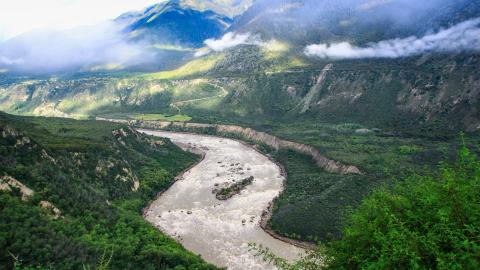Two events in early 2025, the start of construction of the world’s largest hydroelectric power plant in southern China and Pakistani terrorist attacks in Kashmir, have unleashed strong reactions by nations affected by those developments and exacerbated long-standing tensions that threaten stability in Asia.
Chinese civilization and political culture have long been formed by the need to manage water supplies for agriculture and transportation. In the modern era the needs of its huge population and industrial economy have redoubled its efforts to harness the waters flowing from the Himalayan heights. Massive hydroelectric plants such as the Three Gorges Dam (completed in 2006) and the equally ambitious “South-North Water Transfer Project” (begun in 2003 and still under construction) to move more than 25 cubic kilometers annually of water from Tibet and south-central China to the dry but fertile northern plains and industrial centers have reconfigured the natural hydrology of South Asia.
The PRC’s water projects are already affecting the economies and populations of billions of people downstream from the Himalayan plateau and worsening political tensions throughout the region. In July, China announced the start of the largest and riskiest hydroengineering project in history: the so-called Great Bend Dam. This project is located within miles of the Indian province of Arunachal Pradesh and would partially reroute the waters of the world’s largest river – by water flow – the Brahmaputra. Known as the Yarlung Tsangpo before entering India, the Brahmaputra is the primary freshwater resource for Northeast India before entering Bangladesh. It supplies more than 65% of the freshwater for the 175 million people of this impoverished nation. The new system would generate three times the electrical output of the Three Gorges Dam.
India and Bangladesh fear that the new dam complex will inevitably impact the flows of the Brahmaputra and damage the agricultural economies vital to the historical agricultural civilizations of these nations. China has already built 18 dams upstream from the Great Bend. India is wary of potential damage because of the already completed dams and reservoirs in Tibet which affect the flows of the Indus and Ganges rivers, the pillars of India’s agricultural civilization.
The potential dangers of such a massive water management undertaking can be observed in the earlier Chinese construction of 13 dams and reservoirs on the upper Mekong River, before it leaves China for Southeast Asia. Their large reservoirs facilitate electricity production but also control of the timing and amounts of water flowing to the south. Downstream countries fear that waters will be diverted from the reservoirs to eastern and northern China just as those on the Yangtze have done in the South-North system.
A 2022 drought in south China was partially offset by retaining waters in the upper Mekong reservoirs, but this resulted in irregular flows damaging to irrigated lands and aquaculture in Cambodia, Thailand and Vietnam. Rice production in the Mekong Delta, the source of over 50% of Vietnamese production, has been severely reduced in recent years. In Cambodia, 70% of the protein consumption is provided by freshwater ponds fed largely by the Mekong.
China has refused to join the Southeast Asian Mekong River Commission, formed in the 1950s to encourage collective management of the major rivers in the region, transparency in data creation and equitable sharing of the river’s resources. China considers the vast waters originating in its territories in the Himalayan mountains as sovereign resources to be used at its own discretion.
It is also worth observing that the PRC has consistently exhibited disregard for the environmental impacts of its hydroengineering efforts, both within China and downstream. The Big Bend Dam is located in the world’s most earthquake-prone region, and what has been called “the world’s largest and deepest canyon.” The project will create a series of five cascading hydroelectric stations with a combined vertical descent of over two thousand meters. Construction involves carving out tunnels up to 20 kilometers long. In January of this year a 7.1 Richter scale earthquake hit southern Tibet near the Great Bend and damaged five existing dams in China. India and Bangladesh fear the unimaginable consequences of a catastrophic failure of the new dam system or seismic events caused by its construction.
The start of construction on the Great Bend project precipitated a strong response from India. This is in part due to the territorial disputes that have long poisoned Sino-Indian relations. India views – probably correctly – the PRC’s hydro projects near disputed lands in the contested Arunachal Pradesh, as well as in the Kashmir-Jammu regions, as part of the territorial imperialism associated with Xi Jinping’s push to recreate the historical Qing Empire – which extended further south than the current PRC. But the threat to its water supplies constitutes a more important source of concern. As much as 30% of India’s freshwater originates in the Brahmaputra drainage basin. India has even announced and begun preliminary work on the largest hydroelectric project (13,000 MW) it has ever undertaken, located just downstream from the Great Bend. India’s leaders see this as a means to manage the impact of the larger Chinese water control efforts and generate much-needed electricity for Northeast India, but also to cement its own claims to the contested territory.
Earlier this year, a Pakistani terrorist attack in Kashmir rekindled the longstanding water disputes between India and China’s ally, Pakistan. Six rivers, including the headwaters of the Indus, pass through Kashmir, northwest India and into Pakistan. The 1960 Indus Water Treaty (IWT) divided primary rights for three of the rivers each to the treaty partners. The furious response of India to the terror attack included suspension of the IWT and a 2002 data sharing agreement of the two parties. India also temporarily interrupted water passing through its own territory to Pakistan. An estimated 100% of Pakistan’s hydroelectric power and 80% of its irrigation supply is derived from waters passing through disputed Kashmiri territory or India proper.
India’s powerful Home Minister Amit Shah lashed out after the terrorist attacks saying that the IWT would “never be restored,” and vowed to divert more water from the upper Indus areas where it passes through India. A former foreign Minister of Pakistan, Bilawal Bhutto, Pakistani terrorist groups have also threatened to bomb existing Indian dams in the Kashmiri mountains.
India’s diplomatic spokespersons suggest that its threats are primarily rhetorical in nature to challenge and deter further Pakistani terrorist attacks. It is also doubtful that India has the current capabilities to actually interrupt water to Pakistan on a sustainable, large-scale basis. But such threats can spiral out of control since the disputes are foundational to each country and the economic impacts of even small alterations in water flows can be extremely damaging.
Moreover and of comparable concern, India’s threats and potential action tend to validate the water imperialism long employed and recently accelerated by the PRC. In such a volatile part of the world and given the bitter history of land and water disputes, this is obviously a serious escalation. Battles over control of the Himalayan waters affect not only the India-China-Pakistan nexus, but also other Southeast Asian nations with combined populations of over 800 million people already feeling the effects of Chinese water projects.
There is perhaps little that the Western and Pacific Rim allies – including of course the US – can effectively do to deescalate the rising tension over water rights in the Himalayas. However, they should work to give diplomatic support to affected nations in Southeast Asia and urge Chinese and Indian cooperation in such existing agreements as the IWT and the Mekong River Commission.
They could also urge all parties to honor the 1966 UN-brokered Helsinki Rules on transborder water management. These rules support “reasonable and equitable utilization” of all waters that cross national boundaries. Upper riparian nations, according to these customary rules, should provide notice to those downstream and consult on any intervention that materially impacts the timing and size of flows or other actions, such as release of silt downstream, that affect downstream rivers. Effective diplomacy and action among allies could also include technical aid, engineering and construction assistance, and financing for restoration projects. Such help would aid affected downstream nations and offset some of the damage of existing water projects from upstream nations controlling Himalayan waters.
Without sustained international attention, the exploitative dominance of China will continue. Both the populations of South Asia and the global environment will be the victims.



















